High Temperature Ceramics: SiC/SiC, C/SiC, Oxide/Oxide and Protective Coatings
Fiber-reinforced ceramic composites are on the verge of revolutionizing energy and propulsion technologies. SiC/SiC composites will be flying in commercial aircraft engines within the next year and aggressive plans are being hatched by engine OEMs in the US and abroad to use these composites in turbine vanes and blades. The payoffs in engine efficiency – resulting from lower density and higher temperature capabilities of SiC/SiC relative to superalloys – will be enormous. Larger-scale engine nozzle components will soon be made out of all-oxide ceramic composites. And C-fiber SiC-matrix composites for use in ultrahigh temperature applications in hypersonic flight vehicles are actively being developed.
Research in our group addresses the critical materials challenges of high-temperature fiber-reinforced ceramic composites. Research thrusts embrace all aspects of materials technology, including design, synthesis, processing, characterization and modeling of composites, their constituents and protective coatings. The work has been supported through alliances with OEMs and by numerous government agencies, including ONR, AFRL, AFOSR and NASA.

Surface topography at various length scales of one face of a partially-processed 3D C/SiC composite. Such measurements are used to characterize in-plane weave variability in textile composites.
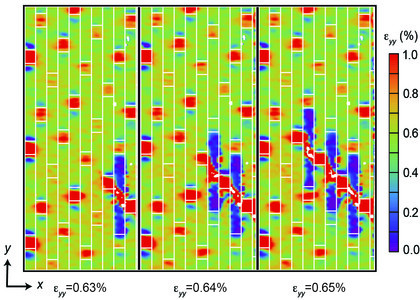
Full-field strain maps in a 2D woven SiC/SiC composite during tensile testing. Locations of tow boundaries in the surface ply are indicated by the white lines.
M. N. Rossol, T. Fast, D. B. Marshall, B. N. Cox and F. W. Zok, 2015, Characterizing in-plane geometrical variability in textile ceramic composites, Journal of the American Ceramic Society, 98, 1, 205-213, WOS:000347302000031
M. N. Rossol, V. P. Rajan and F. W. Zok, 2015, Effects of weave architecture on mechanical response of 2D ceramic composites, Composites Part A-Applied Science and Manufacturing, 74, 141-152, WOS:000356553600017
J. H. Shaw, M. N. Rossol, D. B. Marshall and F. W. Zok, 2015, Effects of tow-scale holes on the mechanical performance of a 3D woven C/SiC composite, Journal of the American Ceramic Society, 98, 3, 948-956, WOS:000351050300038
V. P. Rajan, J. H. Shaw, M. N. Rossol and F. W. Zok, 2014, An elastic-plastic constitutive model for ceramic composite laminates, Composites Part A-Applied Science and Manufacturing, 66, 44-57, WOS:000342955600005
V. P. Rajan and F. W. Zok, 2014, Matrix cracking of fiber-reinforced ceramic composites in shear, Journal of the Mechanics and Physics of Solids, 73, 21, WOS:000347023600002
V. P. Rajan and F. W. Zok, 2014, Stress distributions in bluntly-notched ceramic composite laminates, Composites Part A-Applied Science and Manufacturing, 60, 15-23, WOS:000334000100003
J. H. Shaw, V. P. Rajan, M. Blacklock and F. W. Zok, 2014, Towards virtual testing of textile composites: calibration of thermoelastic tow properties, Journal of the American Ceramic Society, 97, 4, 1209-1217, WOS:000333550500033
W. Xu, F. W. Zok and R. M. McMeeking, 2014, Model of oxidation-induced fiber fracture in SiC/SiC composites, Journal of the American Ceramic Society, 97, 11, 3676-3683, WOS:000344779900052
M. N. Rossol, J. H. Shaw, H. Bale, R. O. Ritchie, D. B. Marshall and F. W. Zok, 2013, Characterizing weave geometry in textile ceramic composites using digital image correlation, Journal of the American Ceramic Society, 96, 8, 2362-2365, WOS:000322965300003
V. P. Rajan, M. N. Rossol and F. W. Zok, 2012, Optimization of digital image correlation for high-resolution strain mapping of ceramic composites, Experimental Mechanics, 52, 9, 1407-1421, WOS:000310892100013
V. P. Rajan and F. W. Zok, 2012, Effects of non-uniform strains on tensile fracture of fiber-reinforced ceramic composites, Journal of the Mechanics and Physics of Solids, 60, 12, 2003-2018, WOS:000309296700002
M. D. Novak and F. W. Zok, 2011, High-temperature materials testing with full-field strain measurement: experimental design and practice, Review of Scientific Instruments, 82, 11, WOS:000297941100050
Architectured Materials: Foams, Lattices and Sandwiches
Inspired by the exquisite cellular assemblies found in Nature, we are pursuing strategies for the design of new synthetic ultra-lightweight structural materials with unprecedented property profiles, including high specific stiffness and strength as well as energy absorbing capabilities. On one front, large-scale computations are being used to sweep through multi-dimensional design spaces and identify designs of periodic cellular structures with desirable characteristics. Collaborative activities with ARL are focused on manufacturing of new structures via additive manufacturing routes. Numerical approaches for solving problems in complex nonlinear systems are also being developed and used for simulation and design of novel lattices that employ an elastic snap-through instability to provide high dynamic energy dissipation. In parallel, a framework within which strut-based truss structures can be systematically classified has been devised and is being used to identify truss topologies with unique mechanical and functional properties.
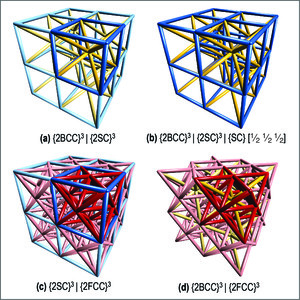
Compound cubic trusses
Polar plots of Young’s modulus: Evolution in compound simple cubic/body centered cubic trusses.
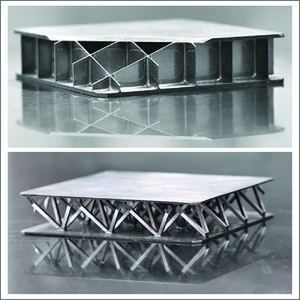
Metallic sandwich panels with honeycomb or truss cores.
O. Nazarian, M. R. Begley and F. W. Zok, 2015, A concept for mitigating head injury under translational blunt impact, International Journal of Crashworthiness, 20, 5, 483-494, WOS:000359596000005
M. R. Begley and F. W. Zok, 2014, Optimal material properties for mitigating brain injury during head impact, Journal of Applied Mechanics-Transactions of the ASME, 81, 3, WOS:000330350100014
C. I. Hammetter and F. W. Zok, 2014, Compressive response of pyramidal lattices embedded in foams, Journal of Applied Mechanics-Transactions of the ASME, 81, 1, WOS:000328262300006
C. I. Hammetter, R. G. Rinaldi and F. W. Zok, 2013, Pyramidal lattice structures for high strength and energy absorption, Journal of Applied Mechanics-Transactions of the ASME, 80, 4, WOS:000326177600029
R. G. Rinaldi, C. I. Hammetter and F. W. Zok, 2013, Ameliorating property gradients in photocured polymer lattices via thermal curing, Materials Letters, 105, 155-158, WOS:000321081200042
J. B. Ostos, R. G. Rinaldi, C. M. Hammetter, G. D. Stucky, F. W. Zok and A. J. Jacobsen, 2012, Deformation stabilization of lattice structures via foam addition, Acta Materialia, 60, 19, 6476-6485, WOS:000311188400004
R. G. Rinaldi, J. Bernal-Ostos, C. I. Hammetter, A. J. Jacobsen and F. W. Zok, 2012, Effects of material heterogeneities on the compressive response of thiol-ene pyramidal lattices, Journal of Materials Science, 47, 18, 6621-6632, WOS:000305804800017
Materials for Threat Protection: Ceramics, Cermets and Fiber Composites
Design of improved ballistic protection systems can be aided significantly with computational simulations. Simulations allow for efficient scanning of a wide design space as well as a broad range of impact scenarios. They also allow assessment of the efficacy of multi-layered multi-material systems. But the fidelity of computed outcomes is predicated on the use of high-fidelity models of material deformation, comminution and fracture under very high strain rates. The goal of our research program has been to advance the understanding of damage and failure modes in armor ceramics and cermets as well as the deformation response of high-performance fiber-reinforced polymer composites. To this end, we have devised and executed experiments that allow for critical assessments of the predictive capabilities of existing and new emerging constitutive models.
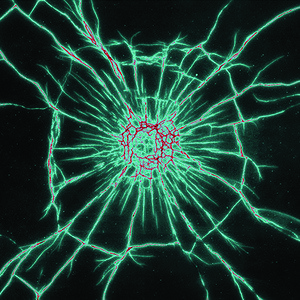
Impact damage on alumina tile (B.G. Compton).
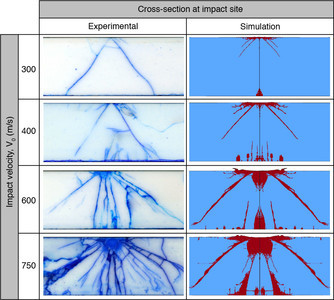
Computed and observed damage patterns in impacted alumina tiles. Computed results taken at 17 ms from first contact (immediately after projectile rebound).
Video of x-ray computed tomography images of crack pattern in alumina after high velocity impact (E.A. Gamble, A.N. Seagraves).
C. C. Holland, E. A. Gamble, F. W. Zok, V. S. Deshpande and R. M. McMeeking, 2015, Effect of design on the performance of steel-alumina bilayers and trilayers subject to ballistic impact, Mechanics of Materials, 91, 241-251, WOS:000366774400017
M. R. O'Masta, B. G. Compton, E. A. Gamble, F. W. Zok, V. S. Deshpande and H. N. G. Wadley, 2015, Ballistic impact response of an UHMWPE fiber reinforced laminate encasing of an aluminum-alumina hybrid panel, International Journal of Impact Engineering, 86, 131-144, WOS:000365363700011
O. Nazarian and F. W. Zok, 2014, Constitutive model for the shear response of Dyneema fiber composites, Composites Part A-Applied Science and Manufacturing, 66, 73-81, WOS:000342955600008
O. Nazarian and F. W. Zok, 2014, Shear-dominated plastic behavior of a cross-ply Dyneema composite, Composites Part A-Applied Science and Manufacturing, 67, 316-323, WOS:000344203600035
B. G. Compton and F. W. Zok, 2013, Impact resistance of tic-based cermets, International Journal of Impact Engineering, 62, 75-87, WOS:000324899300007
B. G. Compton, E. A. Gamble and F. W. Zok, 2013, Failure initiation during impact of metal spheres onto ceramic targets, International Journal of Impact Engineering, 55, 23, WOS:000316042500002
E. A. Gamble, B. G. Compton and F. W. Zok, 2013, Impact response of layered steel-alumina targets, Mechanics of Materials, 60, 80-92, WOS:000317377500006
H. N. G. Wadley, M. R. O'Masta, K. P. Dharmasena, B. G. Compton, E. A. Gamble and F. W. Zok, 2013, Effect of core topology on projectile penetration in hybrid aluminum/alumina sandwich structures, International Journal of Impact Engineering, 62, 99-113, WOS:000324899300009
B. G. Compton, E. A. Gamble, V. S. Deshpande and F. W. Zok, 2012, Damage development in an armor alumina impacted with ductile metal spheres, Journal of Mechanics of Materials and Structures, 7, 6, 575-591, WOS:000312712000003
V. S. Deshpande, E. A. N. Gamble, B. G. Compton, R. M. McMeeking, A. G. Evans and F. W. Zok, 2011, A constitutive description of the inelastic response of ceramics, Journal of the American Ceramic Society, 94, S204-S214, WOS:000292209200023